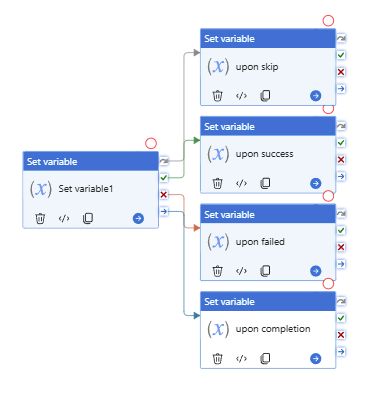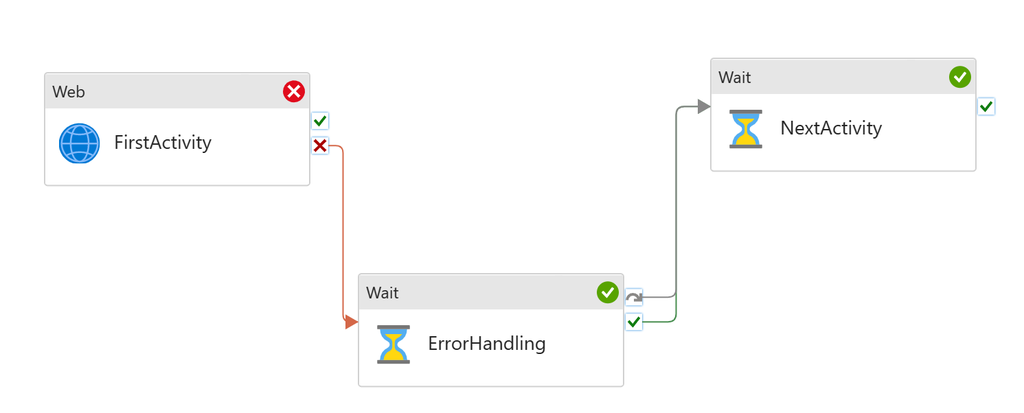

Understanding how failures in individual activities affect the pipeline as a whole is crucial for building robust data workflows.
Some people have used SSIS previously, when they switch from SSIS to the Azure Data Factory and Synapse, they might confuse in ADF or ASA ‘s “pipeline logical failure mechanisam” ADF or ASA’s pipeline orchestration allows conditional logic and enables the user to take a different path based upon outcomes of a previous activity. Using different paths allows users to build robust pipelines and incorporates error handling in ETL/ELT logic.
ADF or ASA activity outcomes path
ADF or ASA has 4 paths in total.
A pipeline can have multiple activities that can be executed in sequence or in parallel.
- Sequential Execution: Activities are executed one after another.
- Parallel Execution: Multiple activities run simultaneously.

You are able to add multiple branches following an activity, for each pipeline run, at most one path is activated, based on the execution outcome of the activity.

Error Handling Mechanism
When an activity fails within a pipeline, several mechanisms can be employed to handle the failure:
In most cases, pipelines are orchestrated in Parallel, Serial or Mixed model. The key point is understanding what will happen in Parallet or Serial model.
From upon activity point of view, the basic principles that are:
Multiple dependencies with the same source are logical “OR”
Multiple dependencies with different sources are logical “AND”
Different error handling mechanisms lead to different status for the pipeline: while some pipelines fail, others succeed. We determine pipeline success and failures as follows:
- Evaluate outcome for all leaves activities. If a leaf activity was skipped, we evaluate its parent activity instead.
- Pipeline result is success if and only if all nodes evaluated succeed
Let us discuss in detail.
Multiple dependencies with the same source
This seems like “Serial” or “sequence”
How “Serial” pipeline failure is determined
As we develop more complicated and resilient pipelines, it’s sometimes required to introduce conditional executions to our logic: execute a certain activity only if certain conditions are met. At this point, as long as one or more activities failed while one or other activities success in a pipeline, what is the status of the entire pipeline? Success? Failure? How are pipeline failure determined?
In fact, ADF/ASA has unique insight. Software engineers are used to customary form:
“if … then … else …”; try … catch …”, let’s use the developer’ idiom
| Single upon activity or Serial model, multiple downstream | Upon activity | Downstream successful path act1 | Downstream failure path act2 | Pipeline Status shows | comment | |
| try .. catch … | Downstream success path only | Success | Success | Success | ||
| Downstream success path only | Failed | Success | Failed | |||
| Downstream failure path only | Failed | Failed | Failed | |||
| Downstream failure path only | Failed | Success | Success | not really success | ||
| If …then ..else … | Both success & failure path | Success | Success | Success | ||
| Both success & failure path | Failed | Success | Failed | |||
| Both success & failure path | Failed | Failed | Failed | |||
| If .. Skip.. Else … | Both success & failure and skip | Success | Success | Skip | Success | |
Scenario 1: Try … catch …
Downstream success path only:
upon act success >> downstream act success >> pipeline Success

Downstream success path only:
upon act failed >> downstream act success >> pipeline Failed

Downstream failure path only
upon act failed >> downstream act success >> pipeline success

Scenario 2:
If … then … Else …
Pipeline defines both the Upon Failure and Upon Success paths. This approach renders pipeline fails, even if Upon Failure path succeeds.
Both success & failure path
upon act failed >> downstream act failed >> pipeline success

Both success & failure path
upon act failed >> downstream failed >> pipeline failed

Scenario 3
If …Skip… Else ….
Both success & failure path, and skip path
upon act success >> downstream act success >> skip path is skipped >> pipeline success

Multiple dependencies with different sources
This seems like “Parallel”, its logical is “And”
Scenario 4:
Upon act 1 success and upon act 2 success >> downstream act success >> pipeline success.

Upon act 1 success and upon act 2 failed >> downstream act success >> pipeline success.

pay attention to the “Set variable failed” uses “fail” path.
That mean:
“set variable success” the action is true
Although “set variable failed” activity failed, but “set variable failed” the action is true.
so both “set variable success” and “set variable failed” the two action true.
pipeline shows to “success”
Now, let’s try this:
the “Set variable failed” uses “success” path, to see what pipeline shows, pipeline failed.

Why? since the “Set variable failed” action is not true. even if the “set variable success” action is True. True + False = False. follow activity – “set variable act” is skipped. will not execute, will not run! pipeline failed!
All right, you might immediately realize that once we let the “Set variable failed” path uses “complete”, that means no matter it true or false, the downstream activity “set variable act” will not be skipped. Pipeline will show success.

Error Handling
Sample error handling patterns
The pattern is equivalent to try catch block in coding. An activity might fail in a pipeline. When it fails, customer needs to run an error handling job to deal with it. However, the single activity failure shouldn’t block next activities in the pipeline. For instance, I attempt to run a copy job, moving files into storage. However it might fail half way through. And in that case, I want to delete the partially copied, unreliable files from the storage account (my error handling step). But I’m OK to proceed with other activities afterwards.
To set up the pattern:
- Add first activity
- Add error handling to the UponFailure path
- Add second activity, but don’t connect to the first activity
- Connect both UponFailure and UponSkip paths from the error handling activity to the second activity

Error Handling job runs only when First Activity fails. Next Activity will run regardless if First Activity succeeds or not.
Generic error handling
We have multiple activities running sequentially in the pipeline. If any fails, I need to run an error handling job to clear the state, and/or log the error.
For instance, I have sequential copy activities in the pipeline. If any of these fails, I need to run a script job to log the pipeline failure.
To set up the pattern:
- Build sequential data processing pipeline
- Add generic error handling step to the end of the pipeline
- Connect both Upon Failure and Upon Skip paths from the last activity to the error handling activity

The last step, Generic Error Handling, will only run if any of the previous activities fails. It will not run if they all succeed.
You can add multiple activities for error handling.

Summary
Handling activity failures effectively is crucial for building robust pipelines in Azure Data Factory. By employing retry policies, conditional paths, and other error-handling strategies, you can ensure that your data workflows are resilient and capable of recovering from failures, minimizing the impact on your overall data processing operations.
if you have any questions, please do not hesitate to contact me at william. chen @mainri.ca (remove all space from the email account 😊)

